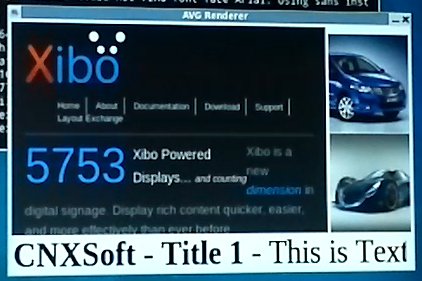Those following my blog know that I recently bought a Mele A1000 to play around. For those who are not familiar with this device, the Mele A1000 is a $70 Android set-top box featuring an AllWinner A10 cortex A8 processor and lots of peripherals, and it can easily be hacked to run a Linux distributions.
This hardware would also be a great digital signage player thanks to its video playback capabilities: up to 2160p video decoding and 1080p video output. Last year, I ported Xibo, an open source digital signage player, to ARM and ran it in the Beagleboard emulator (qemu), but I hadn’t had the opportunity to try it out in a real hardware.

I’ve tried this rootfs based on Linaro ARM Linux Internet Platform (ALIP) image for BeagleBoard in the Mele A1000, by following an adaptation of the method I provided earlier.
For this demo, I created a layout in Xibo dashboard with 4 zones as pictured above:
- A scrolling text zone at the bottom
- 2 small picture zones on the right of the screen
- 1 large zone displaying images and a copy of xibo.org.uk website store in a server in the LAN.
You can see the result in the video below:
There is no hardware acceleration (OpenGL ES) yet, so the performance is not great but once the community provides OpenGL ES/OpenVG acceleration X11 for Allwinner A10 (Mali-400 GPU), the performance should be much better. Currently, rendering the scrolling text makes python use close to 100% of CPU usage at all times, and it’s much less smoother than on a regular PC. I’ve also tried some low bitrate videos, but only the first picture is shown. libavg would have to support AllWinner cedarX API in order to take advantage of video hardware decoding and play high definition videos either directly or via gstreamer. Another limitation is the lack of flash support, and this will never be fixed.
Nonetheless, the current version seems to run fine to display pictures, static text and HTML pages without flash or java.
I’ll provide Here’s the SD card image in case somebody is interesting in trying Xibo in the Mele A1000, or for those who just want to try out ALIP.
If you want to know more about Xibo, you can check my tutorial and/or go directly to Xibo.org.uk. To know more about the Mele A1000, you can check the specifications and read the review of Mele A1000 I wrote last month.

Jean-Luc started CNX Software in 2010 as a part-time endeavor, before quitting his job as a software engineering manager, and starting to write daily news, and reviews full time later in 2011.
Support CNX Software! Donate via cryptocurrencies, become a Patron on Patreon, or purchase goods on Amazon or Aliexpress




